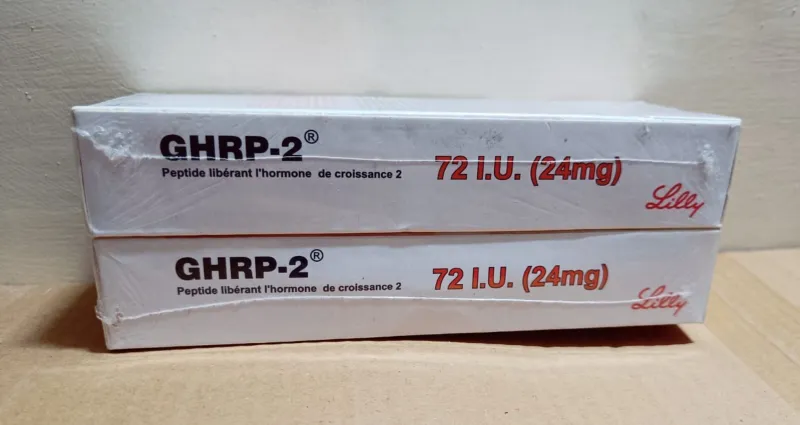
Modified GRF 1-29 (also referred to as CJC-1295 without DAC) and GHRP-2 (Growth Hormone Releasing Peptide-2) are synthetic peptides with properties that have drawn significant attention in the field of biochemical and physiological research. Their synergistic mechanisms of action, structural characteristics, and speculative impacts on cellular and systemic processes in research models present intriguing possibilities for research across various scientific domains.
This article examines the hypothesized properties of these peptides and their potential implications in experimental and preclinical settings, emphasizing their potential to advance knowledge in growth modulation, cellular regeneration, and metabolic optimization.
Structural and Functional Overview
Modified GRF 1-29: Stability and Bioactivity
Modified GRF 1-29 is a truncated analog of growth hormone-releasing hormone (GHRH) designed to maintain activity while supporting stability. GHRH is an endogenously occurring peptide that stimulates the pituitary gland to release growth hormone (GH). Unlike the endogenous molecule, Modified GRF 1-29 is believed to incorporate substitutions at specific amino acid residues, such as replacing methionine with norleucine, to support resistance to enzymatic degradation. This modification may extend the peptide's half-life, allowing for more sustained impacts in experimental systems.
The peptide seems to suggest a selective binding affinity for GHRH receptors, suggesting potential for exploring GH-related pathways. Its structural integrity makes it an attractive candidate for investigating processes such as protein synthesis, cellular growth, and recovery mechanisms in research models.
GHRP-2: Activity via the Ghrelin Pathway
GHRP-2 belongs to the family of growth hormone-releasing peptides believed to interact with the ghrelin receptor (also referred to as the growth hormone secretagogue receptor, or GHS-R). This interaction appears to trigger signaling cascades associated with GH release. GHRP-2 is theorized to mimic ghrelin, an endogenous peptide hormone involved in hunger hormone signal regulation, energy homeostasis, and GH secretion.
By activating GHS-R, GHRP-2 has been hypothesized to exhibit a dual capacity for influencing both GH release and metabolic activity. Its activity has sparked investigations into the modulation of anabolic processes and adaptive responses to environmental stressors in experimental models.
Mechanistic Synergy Between Modified GRF 1-29 and GHRP-2
The combination of Modified GRF 1-29 and GHRP-2 in research experiments has been hypothesized to elicit complementary impacts on GH release. While Modified GRF 1-29 might act directly on the pituitary through GHRH receptor stimulation, GHRP-2 appears to engage additional pathways via ghrelin receptor activation. This dual-action mechanism may amplify GH pulsatility, a phenomenon speculated to support downstream processes related to tissue growth and repair.
Research indicates that the blend may provide unique insights into:
● Pulsatile Hormonal Dynamics
GH is secreted in pulses, and this temporal pattern is crucial for its biological impacts. Investigations purport that combining these peptides may help delineate the factors influencing pulsatile hormone release and its possible role in maintaining systemic balance.
● Intracellular Signaling Pathways
The simultaneous activation of GHRH and ghrelin receptors may enable the study of intersecting intracellular signalingpathways, including cAMP and PI3K-Akt pathways. Understanding these mechanisms might help elucidate the regulatory networks governing cellular growth and metabolism.
Speculative Implications in Scientific Domains
● Cellular and Tissue Regeneration
The blend of Modified GRF 1-29 and GHRP-2 has been theorized to promote regenerative processes by influencing protein synthesis and cellular turnover. Experimental systems employing these peptides might explore their impact on muscle cells, connective tissues, and other proliferative cell types. This may provide valuable insights into recovery from trauma, surgery, or other stressors in research models.
Researchers have speculated that the peptides may support collagen production and angiogenesis, key processes in tissue repair and adaptation. These properties make the blend a compelling candidate for studying wound healing and structural regeneration under controlled conditions.
● Metabolic Research
GH is intricately linked to metabolic regulation, influencing carbohydrate, lipid, and protein metabolism. By augmenting GH release, the peptide blend has been hypothesized to enable investigations into energy utilization and nutrient partitioning. For instance, studies might explore how these peptides modulate glucose uptake in skeletal muscle or lipid metabolism in adipose tissue.
Such research might also assess the impact of these peptides on mitochondrial biogenesis and oxidative stress, contributing to a broader understanding of metabolic resilience and efficiency.
● Cellular Aging and Longevity Research
The GH/IGF-1 axis has been a focal point of cellular aging research due to its association with cellular senescence, genomic stability, and cellular lifespan. Studies suggest that Modified GRF 1-29 and GHRP-2 may offer a tool for probing this axis in experimental systems. For example, these peptides might be of interest to researchers studying the influence of better-supported GH pulsatility on cellular age-related changes in tissues or the potential mitigation of oxidative damage.
It has been proposed that research models focusing on sarcopenia, cognitive decline, or other cellular age-associated conditions might profit from incorporating these peptides to evaluate their speculative roles in preserving function over time.
● Stress and Adaptation Studies
The ghrelin pathway activated by GHRP-2 has also been linked to stress adaptation, particularly in relation to energy conservation and behavioral responses. This aspect positions the peptide blend as a candidate for examining the physiological and neuroendocrine adaptations to environmental or metabolic stressors.
By pairing Modified GRF 1-29 and GHRP-2, researchers may hypothesize new connections between GH dynamics and stress-related hormonal cascades, potentially yielding data on how to maintain equilibrium under challenging conditions.
Considerations for Experimental Design
While the research possibilities with Modified GRF 1-29 and GHRP-2 are expansive, careful experimental design is necessary to realize their full potential. Parameters such as timing, frequency, and synergistic interactions require precise calibration to model physiological conditions accurately.
Moreover, exploring their impact on diverse tissue types, from skeletal muscle to neural tissues, might help clarify the broader systemic implications of these peptides. Utilizing advanced imaging techniques, omics approaches, and computational modeling may further support the depth of understanding derived from such studies.
Conclusion
The Modified GRF 1-29 and GHRP-2 peptide blend represent a promising avenue for scientific exploration, offering potential insights into growth modulation, metabolic optimization, and regenerative processes. Their complementary mechanisms of action provide a versatile platform for investigating complex physiological phenomena in research models. By leveraging these peptides, researchers may uncover novel pathways and interactions, advancing the frontier of biological sciences. This intriguing blend serves as an exemplar of how synthetic peptides might facilitate innovative experimental approaches, fostering a deeper understanding of the intricate systems that govern life.
References
[i] Bidlingmaier, M., Strasburger, C. J., & Wu, Z. (2010). The growth hormone/IGF-I axis and aging. Endocrinology and Metabolism Clinics of North America, 39(2), 191–202. https://doi.org/10.1016/j.ecl.2010.02.001
[ii] Chia, D. J. (2014). Minireview: Mechanisms of growth hormone-mediated gene regulation. Molecular Endocrinology, 28(7), 1012–1025. https://doi.org/10.1210/me.2014-1048
[iii] Nass, R., Pezzoli, S. S., Oliveri, M. C., & Gaylinn, B. D. (2008). Effects of an oral ghrelin mimetic on body composition and clinical outcomes in healthy older adults: A randomized trial. Annals of Internal Medicine, 149(9), 601–611. https://doi.org/10.7326/0003-4819-149-9-200811040-00006
[iv] Devesa, J., Almengló, C., & Devesa, P. (2016). Multiple effects of growth hormone in the body: Is it really the hormone for growth? Clinical Medicine Insights: Endocrinology and Diabetes, 9, 47–71. https://doi.org/10.4137/CMED.S38201
[v] Bowers, C. Y., Momany, F. A., Reynolds, G. A., & Hong, A. (1984). On the in vitro and in vivo activity of a new synthetic hexapeptide that acts on the pituitary to specifically release growth hormone. Endocrinology, 114(5), 1537–1545. https://doi.org/10.1210/endo-114-5-1537


